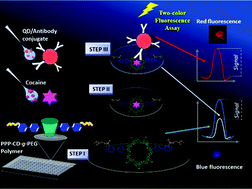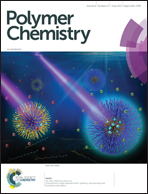Double fluorescence assay via a β-cyclodextrin containing conjugated polymer as a biomimetic material for cocaine sensing†
Abstract
A double fluorescence μ-well assay that exploits a novel conjugated polymer containing cyclodextrin (CD) as the key component is reported. For the construction of the cocaine bioassay, poly(p-phenylene) with CD units in the main-chain and poly(ethylene glycol) side chains (PPP-CD-g-PEG) was first prepared by Suzuki coupling polymerization and coated on each well as a biomimetic material. Although the polyphenylene backbone is responsible for the fluorescence properties without an additional fluorophore, PEG and CD provide water solubility and selective complexation with cocaine, respectively. A cocaine antibody was used as a secondary recognition compound after labelling with quantum dots (QDs). Most notably, we show that the two-color fluorescence nature of the assay facilitates double measurement from the same sample and the described strategy can be adapted to various sensing systems.



 Please wait while we load your content...
Please wait while we load your content...